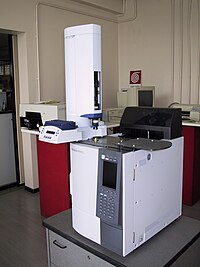Gas-liquid chromatography

Gas-liquid chromatography is like cleaning up your toys. Let's say you have a big pile of toys, and you want to organize them by size. You could start by putting all the small toys in one pile, all the medium toys in another pile, and all the large toys in a third pile.
Gas-liquid chromatography is kind of like that, but instead of toys, we're dealing with different chemicals. Scientists use it to separate out the different chemicals in a mixture, so they can look at them more closely.
Here's how it works: first, we put the mixture we want to analyze into a special machine called a gas chromatograph. This machine heats the mixture up until it becomes a gas.
Then, the gas is passed through a long, thin tube called a column. The column is coated with a special substance, kind of like the outside of a straw. This substance is called the stationary phase.
As the gas travels through the column, different chemicals in the mixture stick to the stationary phase for different amounts of time. Just like how some toys might be bigger or smaller than others, some chemicals might stick to the stationary phase more strongly or weakly than others.
This is where the second part of the name, "liquid chromatography," comes in. Sometimes, scientists add a liquid to the mixture before feeding it into the gas chromatograph. This liquid can help separate the chemicals even more.
By the time the gas gets to the end of the column, the chemicals are all spread out. They've separated out into different "piles," just like your toys.
Finally, the gas comes out of the column and is detected by a special machine. This machine can tell the scientists which chemicals came out of the column, in what order, and how much of each one there is.
Overall, gas-liquid chromatography is a way for scientists to tidy up mixtures of chemicals, so they can study them more easily.
Gas-liquid chromatography is kind of like that, but instead of toys, we're dealing with different chemicals. Scientists use it to separate out the different chemicals in a mixture, so they can look at them more closely.
Here's how it works: first, we put the mixture we want to analyze into a special machine called a gas chromatograph. This machine heats the mixture up until it becomes a gas.
Then, the gas is passed through a long, thin tube called a column. The column is coated with a special substance, kind of like the outside of a straw. This substance is called the stationary phase.
As the gas travels through the column, different chemicals in the mixture stick to the stationary phase for different amounts of time. Just like how some toys might be bigger or smaller than others, some chemicals might stick to the stationary phase more strongly or weakly than others.
This is where the second part of the name, "liquid chromatography," comes in. Sometimes, scientists add a liquid to the mixture before feeding it into the gas chromatograph. This liquid can help separate the chemicals even more.
By the time the gas gets to the end of the column, the chemicals are all spread out. They've separated out into different "piles," just like your toys.
Finally, the gas comes out of the column and is detected by a special machine. This machine can tell the scientists which chemicals came out of the column, in what order, and how much of each one there is.
Overall, gas-liquid chromatography is a way for scientists to tidy up mixtures of chemicals, so they can study them more easily.
Related topics others have asked about:
Analytical chemistry,
Chromatography,
Gas chromatography-olfactometry,
Gas chromatography–mass spectrometry,
High-performance liquid chromatography,
Inverse gas chromatography,
Proton transfer reaction mass spectrometry,
Secondary electrospray ionization,
Selected ion flow tube mass spectrometry,
Standard addition,
Thin layer chromatography,
Unresolved complex mixture
